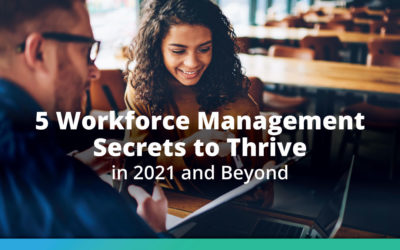Don’t Be Afraid to Give Employees What They Want (Your Bottom Line Will Thank You!)

Creating positive experiences for employees is one of the most neglected practices in organizations across the globe. A mind-shift is in order — one that focuses on changing not only the way value is provided to customers but also for their employees. Company goals are easier to achieve when employees are supported in a collaborative working environment. By creating dynamic employee experiences powered by communications delivered when and where people work, you enable your workforce to align their personal goals with company objectives.
You can do this by creating a positive work environment. However, this goes far beyond providing free lunches and ping pong tables. From the hiring process to the exit formalities, many touchpoints need to be covered. The physical workspace, technology, company culture, and professional relationships — these are some of the aspects employees consider when weighing job offers or when they contemplate how satisfied they are in their current job.
Much has been written highlighting the importance of keeping employees motivated and engaged. Creating a positive employee experience benefits the company greatly, but how will you do it when the traditional ways of working have been turned on their head? The pandemic has forced us to rethink and reconfigure everything. With remote and hybrid work becoming the new norm, organizations need to look beyond the conventional ways of accommodating the needs of their employees, especially taking into consideration deskless shift-based workers who don’t work from home.
Organizations that are able to adapt to challenging times are also more likely to provide a productive environment for their employees.
Listen to Your Employees
Delivering excellent employee experience depends on data. Mapping the employee journey will help you gather the relevant data you need. Instead of relying on assumptions, give priority to what employees have to say and listen to them with an open mind. This is the easiest and the most effective way of improving any relationship.

Though it may seem an overwhelming task, creating a meaningful employee experience does not have to be complicated. Roll out surveys or polls to your workers, inviting them to share their feedback related to workflows and management approaches. Determine the “pain points” that keep your workers from doing their best, and strategize solutions with an open dialogue and communication strategy.
Once an hourly shift worker completes a first-time job, ask in-the-moment questions via chat about their experience. For example;
- Did you have everything you needed to complete the job successfully?
- Were all training and materials available?
- What could improve your experience for next time?
Effectively manage time off and employee absences (including the coordination of leave cases) by reviewing the accruals, upcoming absences, and approving new requests on the same platform. Get notified of possible developing problematic performance issues, like excessive overtime, or habitually clocking in late.
Scheduling can be difficult using out-of-date manual methods. Not all data may be available or accounted for and getting the information out to workers can be an inefficient hassle. With WorkForce Software, this can all be performed within an easy to use app. Have full access to data on previous schedules and overtime at your fingertips, coordinate around pre-approved leave and absences, and keep your employees engaged and informed in the moment.
In every business, individuals are affected by a number of factors. To get to the root of their concerns, you can assess the quality of relationships between employees, teams, managers, and even customers. Understanding these informal networks and connections is important for front-line managers, giving them insights into factors that can affect employee behavior. Through listening, managers can identify perception gaps and develop strategies to close them.
Not A One-Size-Fits-All
Not all job interviews are conducted in the same manner. Similarly, one employee experience approach likely won’t benefit your entire workforce.
An employee with a desk job will often have completely different needs than a deskless shift worker. The gap between these needs has widened since 2020 when the pandemic hit. While most companies adopted technologies that allowed employees with desk jobs to have some sense of normalcy, those who had deskless shift jobs found it harder to adapt to the situations. These employees weren’t given adequate access to the tech tools crucial for them to remain productive and engaged. As a result, many of these employees felt cut off from their organizations.
Some organizations who have not prioritized how they collaborate and communicate with all their employees across various work arrangements run the risk of experiencing “the great resignation” first-hand. You can avoid this by creating employee experience (EX) programs that are practical, easy to execute, and customized to specific employee group needs. Here, HR, Operations, and IT collaborate to build a comprehensive EX strategy. Together they can restructure the existing workforce management and task management applications to create employee experiences that resonate widely.
Get Employee Experience Right
In the past, employee/employer relationships were more transactional, for example issuing a paycheck for services rendered. Today, the relationship is more pronounced. Productive, positive employee experiences are now the bedrock of employer/employee relations. In the same way that marketing teams are now concentrated on the total customer experience, HR is focusing on building strategies that seek to improve the overall employee experience.

The availability of new dynamic feedback tools and integrated employee self-service tools, for instance, are helping HR departments to better understand and raise employee engagement.
Today, employee experience is impacted by several factors:
- Many companies have not yet made employee experience a priority, only addressing this critical area in end-of-year surveys.
- Most organizations are yet to assign responsibility for employee experience strategy and delivery.
- Employee engagement tools need to be updated to help HR teams and line managers better understand what their employees want, expect, and value.
Employees who work hourly shifts can benefit greatly from workforce management tools. In addition to checking on the progress of assigned tasks, these tools make communication easier. Workers can easily access their work schedules, pay information, and other details that can be otherwise missed.
The Business Impact
Continuously working on creating a strong employee experience strategy is no longer optional, it must be atop priority. The pandemic has made this abundantly clear.
While many things are returning to normal, many workers remain reluctant to return to the workforce. For some, money is no longer the primary motivator. Today’s workforce is seeking positions that offer more than just a paycheck. They’re seeking meaning, purpose, flexibility, and the opportunity to develop and grow within a company.
And specifically, deskless shift workers want control of their schedules, a balance of flexibility with consistency, and good communication tools to help them be successful.
People who feel valued and rewarded, who feel a connection to the company culture, and who have a pleasant work environment are more likely to feel engaged throughout the employee lifecycle, whether it’s recruitment, onboarding, training, or on the job.
A Gallup study has found that companies with engaged employees tend to perform better than those with disengaged employees based on the following performance indicators:
- 41% lower absenteeism
- 10% higher customer ratings
- 17% higher productivity
- 20% higher sales
- 21% higher profitability
“In our studies of the world’s most successful organizations, we’ve learned that a culture of high development driven by an effective employee engagement strategy is the most productive environment for both businesses and employees.”
–Gallup’s Study on Employee Engagement and Development
The Great Resignation is real, and if organizations are dragging their heels to invest in building a progressive employee experience, it will negatively impact their business in the long run. In contrast, companies that offer an engaging experience will be able to attract and retain skilled employees and grow. This should come as no surprise because every company knows the cost of hiring and developing a new employee. To avoid becoming a victim of the Great Resignation, focus on designing a great employee experience.
Close the Gap with Employees by Using WorkForce Software
Today’s workforce is becoming increasingly global, diverse, and complex, with full-time, part-time, freelancers, and contractors across generations and locations. A segmented approach to people management can help identify gaps in employee experience initiatives, and increase retention and engagement rates, resulting in happier, committed, and loyal employees.

“People form the backbone of any organization — without them, it wouldn’t exist. Creating an engaging and respectful work environment is essential to every organization’s success.”
–Marc Gingras, SVP of Employee Experience Strategy at WorkForce Software
Adopting a top-down approach is bound to backfire. For any employee experience program to work effectively, it’s important to instill an organization-wide sense of ownership. Understanding what’s important to employees and acting accordingly is the key to stimulating performance.
Technological advances have significantly impacted how employees perform their daily tasks. Communication-related technology, for instance, can speed up employee productivity, helping employees to communicate more efficiently, ticking off tasks faster. With technology that automates processes, employees are freed to work on other, perhaps more pressing assignments. Software packages can collate and dissect valuable data that would otherwise be lost or would require employees to spend considerable time gathering and analyzing. Technology, such as touchscreen computers, can help disabled employees more easily access and operate common office equipment.
In an era where workers are voting with their feet, seeking better work-life balance, higher wages, and more flexibility, organizational resilience requires that employees feel heard, valued, and engaged. According to Gartner, when it comes to digitalizing HR to improve employee experience, CEOs are looking for innovations that can help workforces perform work faster (or perform more work in the same time period). Employees, on the other hand, are looking for relevant personal tools, resources, and support to improve their daily work experiences.
Powerful, elegant, all-in-one, WorkForce Software is designed for the modern workforce. Our dynamic solution comprises a suite of next-generation workforce management tools that speaks to employees of every generation in any location. We can help your business create employee experiences that unlock new potential for innovation, resilience, and better performance.
Looking to implement a holistic approach to employee experience… a solution that’s optimized to boost both morale and margins? Discover how WorkForce Software delivers tangible value across your operations that will yield untapped benefits in employee sentiment, engagement, and retention. Your employees (and your bottom line will thank you!)
Subscribe to The WorkForce Blog
Learn the art and science of maintaining productive, happy, engaged employees.
Discover More
Embedding an ‘Eyes Wide Open’ Mindset Into HR Technology Selection
Gartner guides teams responsible for deciding on their organization’s next HR technology investment to set themselves up for success.
5 Workforce Management Secrets to Thrive in 2021 and Beyond
Download this eBook to learn the 5 secrets that will help your organization shift from surviving to thriving now and in the future and learn how the right workforce management solution can empower your initiatives.
Reshaping Workforce Management Strategies to Meet Growing Employee Expectations
See how evolving preferences and pivotal factors have led to a transformative shift in workforce expectations.



